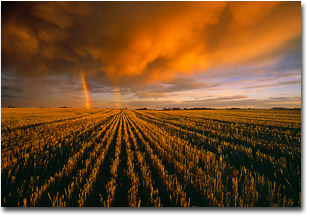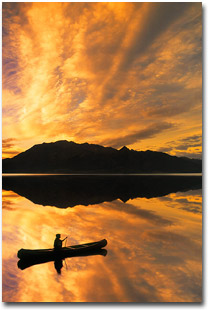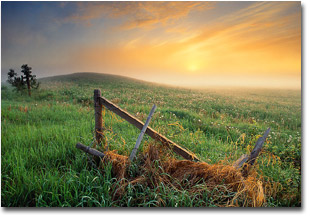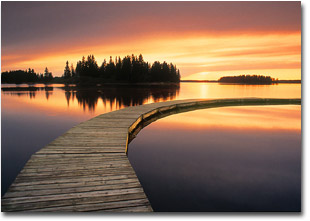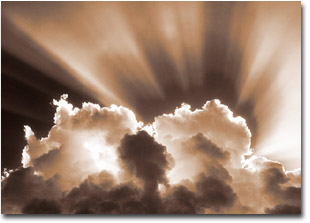|
|

Send in the Clouds
Text and photography Copyright Darwin Wiggett For me, the most memorable landscape photos almost always have a sky that is full of interest, and most often, that interest comes from clouds. Give me a weather forecast of mixed sun and cloud, and I am in photographic heaven. Let’s take a look at how to get great landscape photos through the inclusion of cloudy skies. Setting Yourself Up for Great Skies The absolute best way to get great clouds and skies is to always be out shooting! Of course that solution isn’t practical. All of us have time constraints and often we can’t get out when the skies are amazing. But if I hear that there is mixed weather in the forecast, I try to make time to sneak out. The best skies happen at the edges of weather, so getting out before or after a storm is good idea (see Photo 1). If possible, it is best to get out at the edges of the day (sunrise and sunset) because the differential in temperatures (cool to warm in morning, and warm to cool in evening) often causes clouds to form. Keeping track of forecasts, learning about atmospheric changes that signal cloud formation, and getting out as often as possible are the things that serious landscape shooters do to get themselves under interesting skies.
The Sunrise/Sunset Challenge Most photographers recognize that colourful skies often happen at sunrise and sunset. Even on a clear day, the sky takes on an orange glow at dawn and dusk. Sprinkle in a few clouds and the sky will often turn to fire, as the sun under-lights the bellies of the clouds (see Photo 2). The key to successful sunrise and sunset landscape shots is three-fold. First, you have to be out there before the light happens ready with camera in hand. That means getting up before the dawn or staying out after the sun dips below the horizon. Often photographers sleep too long in the morning, or pack up their gear too early in the evening and miss all the action. Second, you need to use the cloud patterns as compositional elements in your photo. That means having a foreground landscape that is complementary to the patterns of cloud in the sky. Often photographers use water (a lake, pond, puddle, or stream) to reflect the clouds into the foreground. Don’t limit yourself to the cliché of sunset over a lake. All sorts of other foregrounds from badlands, to agricultural crops, to fields of flowers will work as compliments to an fiery sky (see Photo 3) Third, you need to narrow the contrast range between the bright sky and the darker foreground. A sunrise or sunset sky is often two to five stops brighter than the landscape foreground. Expose properly for the sky and the landscape turns black, expose for the landscape and the sky washes out. What are your solutions then?
Cloud Popping Once the sun is above the horizon, and the landscape and sky are more evenly lit, it is time to switch to a polarizing filter. Even just a few scattered clouds will jump in a blue sky when you use a polarizer (see Photo 4). Here are a few things to keep in mind when using a polarizer.
Using Clouds as Compositional Elements For really fine landscape photography, it is not enough to have an interesting sky; it is also critical that the sky (and the cloud formation therein) work in harmony with the compositional elements of the landscape. Your viewer’s eye should move seamlessly between the landscape and the sky using elements from both to bind the two halves of the image together (see Photo 5). Use the same guidelines of composition (leading lines, s-curves, negative space, the rule of thirds, balance etc.) in your skies as you would normally do in your landscapes (see Photo 6). Because skies with clouds are so fluid and dynamic it is often difficult to make a finely tuned composition before the clouds move out of position. It seems there are two extremes for me, working super fast, trying to get the shot before the clouds change, or waiting… for a long time, for the clouds to move in position. The hurry-up and wait game is just part of what it takes to do quality landscape photography – but I think the game is worth playing especially for those amazing landscape shots where the sky and the land sing in harmony. Happy cloud hunting! Darwin Wiggett - NPN 343 Editor's Note - Natural Moments Photography is comprised of the husband and wife shooting team of Anita Dammer and Darwin Wiggett. Anita has 17 years experience as staff photographer for the Glenbow Museum in Calgary and is currently doing freelance stock photography. Darwin has been shooting stock since 1990, is a contibuting editor to Canada's "Photo Life" magazine and has two books published by Whitecap in Vancouver ("Darwin Wiggett Photographs Canada" and "Seasons in the Rockies"). Together they specialize in landscape, nature, animal, humor and kid photography. Comments on NPN landscape photography articles? Send them to the editor. |
|
|
